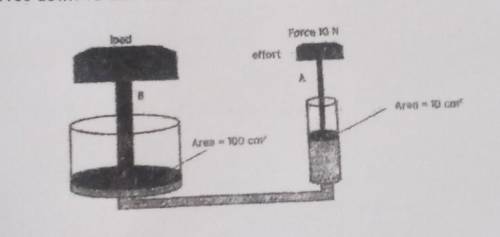
Engineering, 17.05.2021 14:00, Dweath50
In the hydraulic press below, a force of 100 N is applied to piston A and it
moves down 10 cm.
1. Calculate the work done by both pistons.
2. Calculate the pressure of the fluid.
3. Calculate the maximum force that is extorted on the load by piston B.
4. Calculate the distance traveled by piston B.
The information below is just the things I thought weren't very clear in the picture
Piston B: Area-100mm²
Piston A: Area-10mm²
Force-10N


Answers: 1
Other questions on the subject: Engineering

Engineering, 03.07.2019 14:10, makaylashrout77
Amass of 1.5 kg of air at 120 kpa and 24°c is contained in a gas-tight, frictionless piston-cylinder device. the air is now compressed to a final pressure of 720 kpa. during the process, heat is transferred from the air such that the temperature inside the cylinder remains constant. calculate the boundary work input during this process.
Answers: 2

Engineering, 04.07.2019 18:10, ahmedeldyame
Aloaded platform of total mass 500 kg is supported by a dashpot and by a set of springs of effective stiffness 72 kn/m. it is observed that when the platform is depressed through a distance x = 12.5 cm below its equilibrium position and then released without any initial velocity; it reaches its equilibrium position in the shortest possible time without overshoot. find the position and velocity of the loaded platform 0.10 sec. after its release. if a further load of 400 kg is added to the platform, find, i) the frequency of damped vibrations, and i) the amplitude of vibration after 2 complete oscillations, given that the initial amplitude is 15 cm.
Answers: 1


Engineering, 06.07.2019 03:20, harleyandpope90
Aparticle moves along a straight line such that its acceleration is a=(4t^2-2) m/s, where t is in seconds. when t = 0, the particle is located 2 m to the left of the origin, and when t = 2, it is 20 m to the left of the origin. determine the position of the particle when t=4s.
Answers: 1
Do you know the correct answer?
In the hydraulic press below, a force of 100 N is applied to piston A and it
moves down 10 cm.
Questions in other subjects:

Social Studies, 25.09.2020 03:01

History, 25.09.2020 03:01






Mathematics, 25.09.2020 03:01

History, 25.09.2020 03:01







